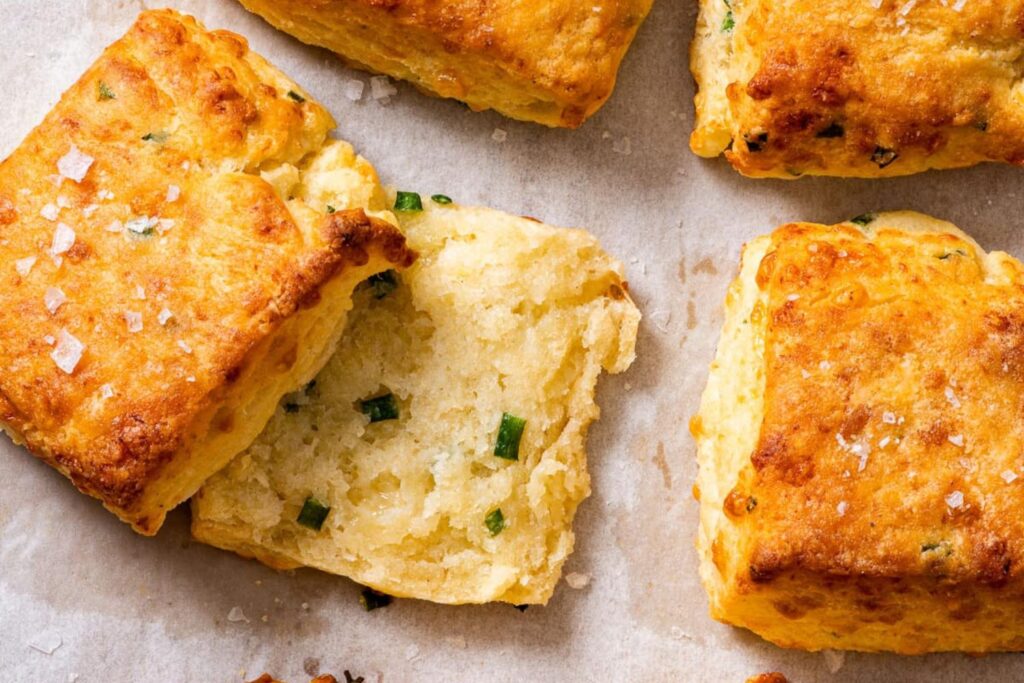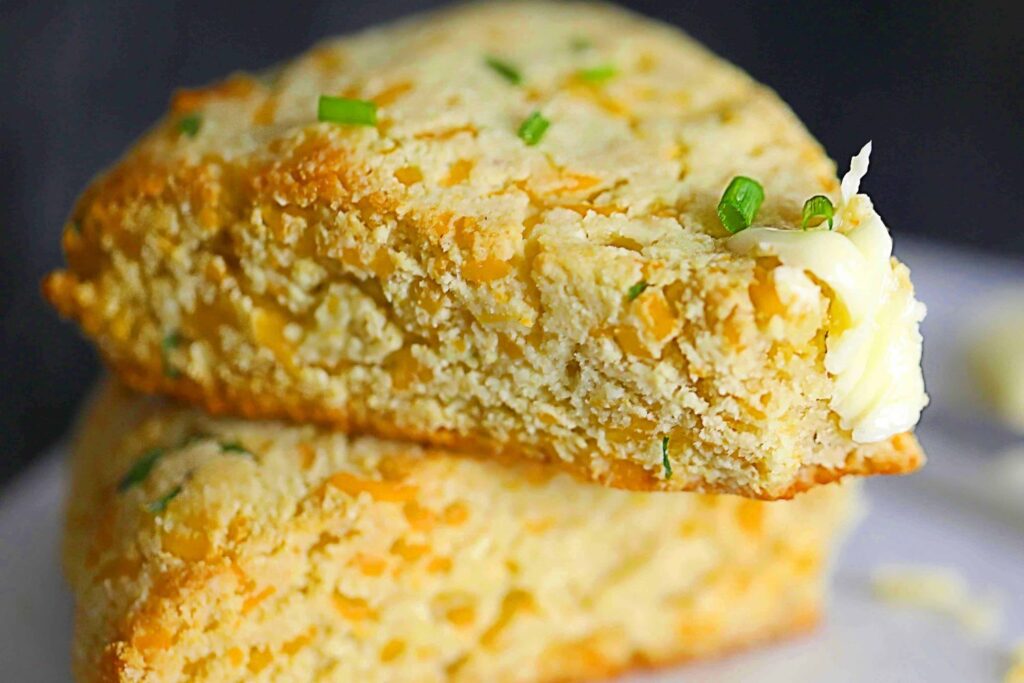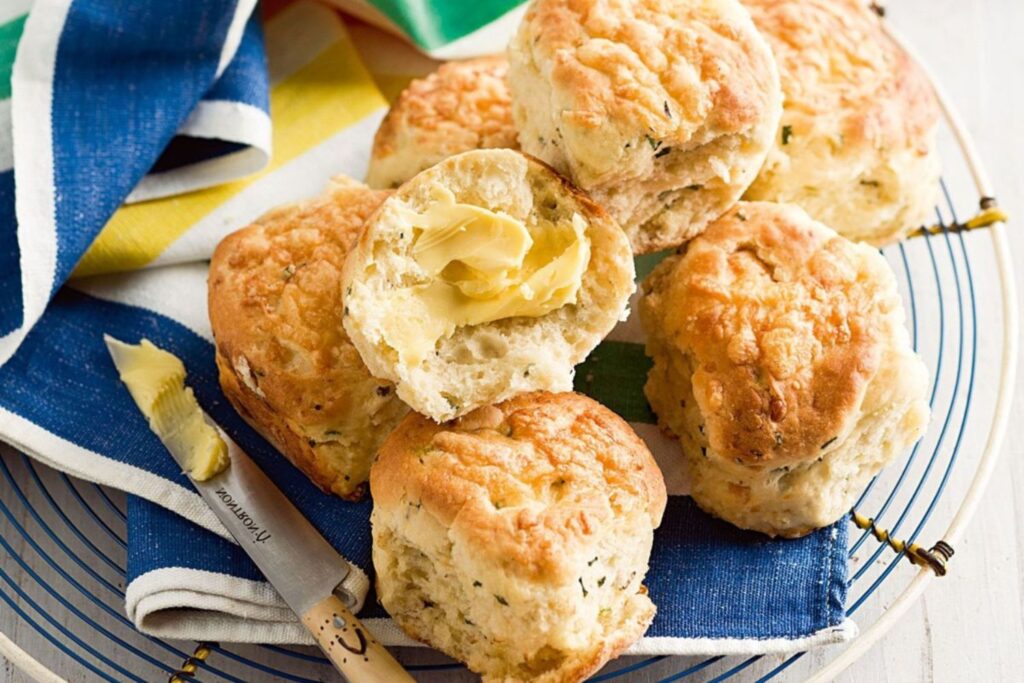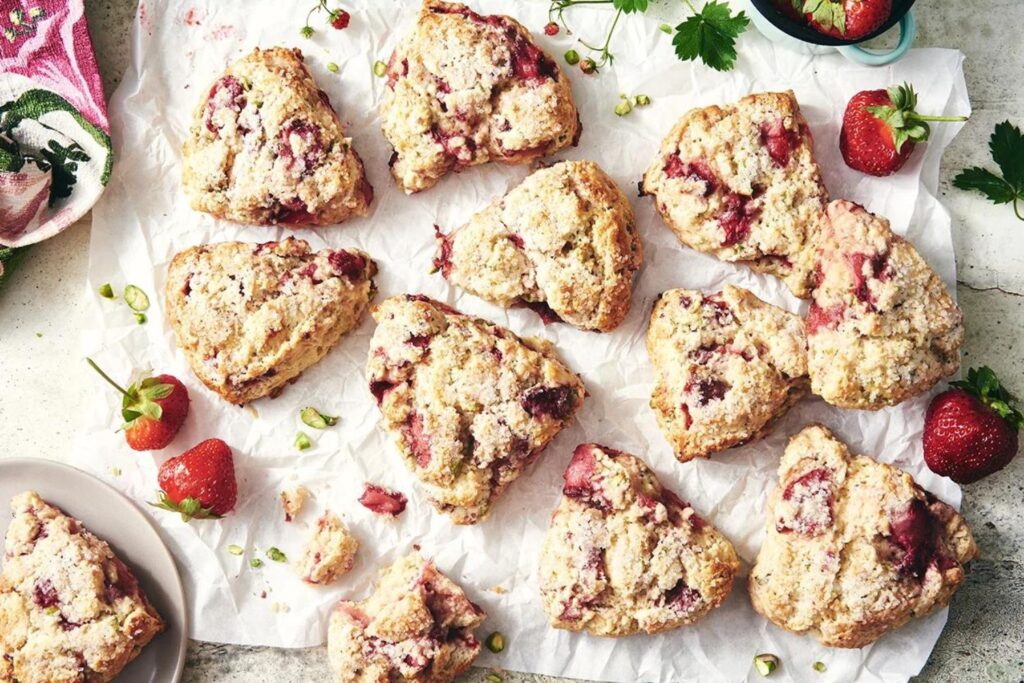A cozy morning sets the tone for the day, where warmth and comfort blend seamlessly. Something is enchanting about starting your day slow, whether it’s the gentle rustling of leaves outside or the soft glow of dawn filtering through the curtains. One essential ingredient to this perfect start? Freshly baked cheddar chive scones. The rich, savory aroma that fills your kitchen as these golden, flaky delights bake is irresistible. Pair it with a steaming cup of coffee or tea, and you have a simple, yet luxurious way to indulge in a peaceful morning. Cozy mornings are about savoring each moment, and nothing complements that better than homemade scones that bring comfort and flavor to your plate.
What Makes Cheddar Chive Scones Irresistibly Flaky?

The secret to achieving irresistibly flaky cheddar chive scones lies in the technique and ingredients. The delicate, layered texture of flakiness comes from incorporating butter into the dough. You gently cut cold, cubed butter into the dry ingredients, ensuring it stays in small, solid pieces instead of blending in. When the scones bake, these small butter pockets melt, creating steam and causing the dough to rise, forming those signature layers. The key is minimal handling of the dough to prevent overworking, which can lead to a dense, tough texture. With cheddar and chives nestled into these layers, the savory explosion that follows each bite is both light and indulgent, making them simply irresistible.
The Magic Combo: Why Cheddar Chive Scones Work Together?
Cheddar and chive may seem like a simple pairing, but together, they create a symphony of savory flavors. Cheddar, with its sharp, robust taste, adds richness and depth to the scones. The cheese melts into the dough, creating pockets of molten goodness. Chives, on the other hand, provide a fresh, mild onion-like flavor that cuts through the richness of the cheddar, adding brightness to each bite. This balance between boldness and freshness makes cheddar and chive a perfect match, creating a flavor profile that is both comforting and exciting. The result is a scone that is satisfying yet not overpowering, making it a versatile option for any time of day.
Essential Ingredients for Flaky Cheddar Chive Scones
To achieve the perfect cheddar chive scone, every ingredient plays a pivotal role. Flour, butter, cheddar, chives, and a few supporting players come together to form a harmonious balance of texture and flavor. Start with high-quality all-purpose flour for structure and butter for that desired flakiness. Fresh chives lend a subtle burst of green flavor, while sharp cheddar brings richness to every layer. Baking powder helps the dough rise just enough for a tender crumb, while a dash of salt enhances the savory notes. These ingredients, though simple, work in tandem to create a scone that’s hearty and flavorful, yet light and flaky.
Choosing the Right Cheese: Best Cheddar Chive Scones

Not all cheddar is created equal, and when it comes to baking scones, the choice of cheese can significantly impact the outcome. Sharp cheddar is often the go-to, as its bold, tangy flavor can stand up to the richness of the butter and the subtlety of the chives. Aged cheddar, with its crumbly texture and deep flavor, melts beautifully, creating those gooey pockets of cheese within the scone. For a milder option, medium cheddar works well, offering a smoother, less intense taste. Whichever you choose, make sure it’s freshly grated for the best melt and distribution throughout the dough.
Fresh or Dried? How to Select the Best Cheddar Chive Scones?
When it comes to adding chives to your cheddar chive scones, fresh is always best. Fresh chives have a delicate, onion-like flavor that elevates the savory profile of the scones without overpowering them. Dried chives, while convenient, often lose their potency and texture during the drying process. They can also become too chewy when rehydrated in the dough. If fresh chives aren’t available, opt for frozen ones as a closer alternative. The key is to finely chop the chives to ensure they are evenly distributed throughout the dough, adding a pop of flavor to every bite.
The Secret to Flaky Layers in Scones
Flaky layers are the hallmark of a well-made scone, and achieving them requires a combination of the right ingredients and technique. The most crucial step is cutting cold butter into the dry ingredients until it forms pea-sized crumbles. These butter pieces remain solid in the dough and, when baked, the water in the butter evaporates, creating steam that puffs up the dough and forms layers. Another tip is to fold the dough gently but firmly, which helps build the layers without overworking the dough. The result is a scone that breaks apart into delicate, buttery flakes with each bite.
How to Mix Dough Without Overworking It?

Overworking the dough is one of the most common mistakes in scone making, and it leads to a tough, dense texture rather than the light, flaky result you’re aiming for. The key is to mix the dough just until the ingredients come together. Start by combining the dry ingredients, then cutting in the butter until it resembles coarse crumbs. When adding the wet ingredients, stir just enough to moisten the flour, stopping as soon as the dough holds together. Avoid kneading or pressing the dough too much—minimal handling is essential for maintaining those flaky layers.
Why Cold Butter Is Key to Flakiness?
The role of cold butter in scone-making cannot be overstated. Cold butter, when incorporated into the dough, creates layers as it melts during baking. These layers form steam, which helps lift the dough, creating that flaky texture we love. If the butter is too warm or soft, it will blend too much into the dough, losing its ability to create steam and resulting in a more cakey, less flaky scone. That’s why it’s essential to keep the butter as cold as possible, even chilling it further after cutting it into the flour if necessary.
Tips for Perfectly Cutting Your Scone Dough
The way you cut your scone dough plays a significant role in how well it bakes. For uniform baking, it’s crucial to roll out the dough evenly to about ¾ inch thick before cutting. Use a sharp knife or a dough cutter for clean edges, as this helps the scones rise properly. Avoid twisting your cutter, as this can seal the edges and prevent proper rising. Whether you’re cutting triangles or circles, ensuring that the dough is cold and firm will also contribute to the perfect rise and structure during baking.
How to Shape Scones For the Best Texture?

The shape of your scones can influence their texture and overall presentation. For traditional triangular scones, pat your dough into a flat round, about ¾-inch thick. Use a sharp knife to cut the circle into wedges, just like cutting a pie. To create circular scones, use a round biscuit cutter. When shaping, it’s important to handle the dough as little as possible. Too much manipulation can compress the layers, reducing flakiness. Cold dough is easier to work with and helps the scones keep their shape while baking.
The Ideal Oven Temperature for Cheddar Chive Scones
Temperature is critical in baking scones. The oven needs to be preheated to 400°F (200°C) to ensure that the scones rise quickly, creating those desirable flaky layers. If the oven temperature is too low, the butter will melt before the scones have a chance to rise, leading to a dense and greasy result. A hot oven ensures that the butter melts quickly, generating steam that lifts the dough, while also giving the scones a beautifully golden crust. Bake in the middle rack for even heat distribution.
How to Achieve a Golden, Crisp Exterior?
Achieving a golden, crisp exterior on your scones adds both texture and visual appeal. The key is to apply a light egg wash on the top of the scones before baking. An egg wash, made from whisked egg with a splash of milk or water, helps to create a shiny, golden-brown finish. Be careful not to let the egg wash drip down the sides of the scones, as this can cause uneven browning. For extra crunch, sprinkle a little sea salt or grated cheese over the top before placing them in the oven.
Choosing The Perfect Baking Sheet

The right baking sheet can make a big difference in how your scones bake. A heavy-duty, light-colored metal baking sheet works best for even heat distribution. Dark or nonstick pans can cause the bottoms to brown too quickly, potentially leading to uneven baking. To prevent sticking, line the baking sheet with parchment paper. This not only ensures easy release but also aids in even browning by allowing air to circulate the scones. A well-chosen baking sheet helps produce scones that are evenly cooked, golden, and perfectly flaky.
Using Egg Wash for a Beautiful Finish
Egg wash is the secret weapon for a perfectly polished finish on cheddar chive scones. A simple mixture of beaten egg and a splash of water or milk is brushed lightly over the tops of the scones just before baking. This step ensures a beautiful, glossy sheen and encourages a rich golden color. Be mindful to only brush the tops—excess wash running down the sides can seal the edges and inhibit the scones from rising properly. For an extra touch, sprinkle some grated cheddar or flaky salt over the egg wash for added texture and flavor.
How Long to Bake Cheddar Chive Scones?
Baking time is crucial for achieving the right texture in cheddar chive scones. Typically, scones should bake for about 15-18 minutes at 400°F (200°C). The key is to look for a golden-brown top and slightly crisp edges, which signals that they are perfectly cooked. However, because oven temperatures can vary, it’s essential to keep a close eye on the scones after the 12-minute mark. Avoid over-baking, as this can dry them out. When done, the scones should feel firm to the touch on the outside but still soft and tender within.
Troubleshooting Common Scone Baking Mistakes

Even with the best intentions, things can go awry when baking scones. If your scones turn out flat, it’s often because the dough was overworked, or the butter wasn’t cold enough, leading to a lack of flakiness. Dense scones can result from using too much liquid or not enough leavening agents like baking powder. Overbaking can lead to dry, crumbly scones, while underbaking leaves them doughy in the middle. Keeping ingredients cold, handling the dough gently, and watching the bake time closely will help avoid these common pitfalls and ensure delicious results.
Serving Cheddar Chive Scones Fresh Out of the Oven
Cheddar chive scones are best enjoyed fresh and warm, right out of the oven. The texture is at its finest just after baking, with a crisp exterior giving way to a soft, tender crumb. To enhance the experience, serve them with softened butter or a dollop of cream cheese for extra richness. The savory flavors also pair well with a dash of hot sauce or a drizzle of honey for a sweet-salty contrast. While fresh is best, you can also store the scones in an airtight container for up to two days, gently reheating them before serving.
Best Pairings for cheddar chive scones
The savory, flaky texture of cheddar chive scones makes them versatile enough to be paired with a variety of dishes. For breakfast or brunch, serve them alongside scrambled eggs, crispy bacon, or smoked salmon to complement the rich cheddar flavor. A simple green salad or a bowl of hearty soup makes for a perfect lunch or light dinner pairing. For a more indulgent treat, consider a slathering of herb-infused butter or a tangy tomato jam. Pair with a hot cup of coffee or tea, and you have a satisfying meal fit for any time of day.
Why Scones Are Perfect For Cozy Mornings?

There’s something undeniably comforting about starting the day with a warm, freshly baked scone. The combination of a crisp, flaky exterior and a soft, buttery interior creates a sense of indulgence without being overwhelming. The savory notes from the cheddar and chives add a satisfying depth of flavor, perfect for slow, cozy mornings spent sipping coffee or tea. Scones also evoke a sense of nostalgia, reminiscent of simpler times when breakfast was a meal to be savored. They’re an ideal way to bring a little extra comfort and joy to your morning routine.
Cheddar Chive Scones as a Savory Breakfast Staple
While many people associate scones with sweetness, cheddar chive scones offer a savory alternative that can easily become a breakfast staple. These scones are hearty enough to stand on their own as a main dish. Yet light enough to complement other morning favorites. They provide a perfect balance of richness from the cheese and brightness from the chives. Making them a delicious alternative to traditional breakfast bread. Whether served with eggs, bacon, or avocado, cheddar chive scones can become a go-to item for anyone seeking a flavorful, satisfying start to the day.
How to Make Ahead and Freeze for Busy Mornings?
One of the best features of cheddar chive scones is their versatility. Especially for busy mornings when time is short but the desire for a hearty, homemade breakfast remains. These scones can be made ahead and frozen, ensuring you have a delicious option at your fingertips whenever the craving strikes. To do this, prepare the dough as instructed, and cut it into your desired shape. Freeze the unbaked scones on a baking sheet for about an hour. Once frozen solid, transfer them to an airtight container or freezer bag, where they can be stored for up to three months.
When you’re ready to bake, there’s no need to thaw. Simply pop the frozen scones onto a lined baking sheet and bake as directed. Adding an extra 3-5 minutes to the baking time. This method ensures that you always have freshly baked scones without the hassle of making dough from scratch every morning. For those who prefer baking ahead, fully baked scones can also be frozen and reheated. Just cool them completely, wrap them tightly, and freeze them. When reheating, place the scones in a preheated oven at 350°F for 10 minutes until warmed through and crispy.
Reheating Scones Without Losing Cheddar Chive Scones

Scones while maintaining their delicate, flaky texture can be tricky, but it’s entirely possible with the right technique. Microwaving, while convenient, often makes scones rubbery and soggy due to uneven heating. Instead, the oven or toaster oven is your best friend when reheating scones. Preheat your oven to 350°F (175°C), place the scones on a baking sheet, and warm them for about 10-12 minutes. This method restores their crispy exterior and keeps the interior soft and flaky. For an added touch of freshness, you can brush a little melted butter on top before reheating. If you’re in a pinch and must use a microwave, wrap the scone in a damp paper towel and heat in short 10-15 second bursts to avoid drying it out.
Turning Leftover Scones into Delicious Snacks
Leftover scones, while not as fresh as when they first came out of the oven, still hold plenty of potential for reinvention. Cheddar chive scones, in particular, can be transformed into tasty snacks with a few simple tweaks. Slice them horizontally and toast lightly for a quick savory sandwich base. Pair with a fried egg, avocado, or crispy bacon for a delightful twist on a breakfast sandwich. Alternatively, crumble leftover scones over a salad or soup for a crunchy, cheesy topping that enhances the flavor profile of your dish.
Consider slicing and grilling your leftover scones with a little butter for a different approach. This brings back their crispy texture and adds a caramelized richness. You can also repurpose them as a savory base for mini pizzas—spread a little tomato sauce, top with extra cheddar or mozzarella, and bake until the cheese bubbles. Leftover scones provide endless opportunities for creative snacking, ensuring that none of their deliciousness goes to waste.
Creative Variations of Cheddar Chive Scones
While cheddar and chive are a match made in savory heaven, scones lend themselves beautifully to a variety of creative flavor combinations. For a heartier, more robust scone, consider adding crumbled bacon to the dough for a smoky element. If you’re looking for a touch of sweetness, diced caramelized onions or roasted red peppers can provide a subtle contrast to the sharpness of the cheddar. Herbs such as rosemary or thyme can also be used in place of, or in addition to, the chives for an earthier flavor.
For a more decadent version, swap out the cheddar for blue cheese or Gruyère, both of which melt beautifully and bring a sophisticated depth of flavor. You can even add a bit of heat by incorporating diced jalapeños or a pinch of cayenne pepper into the dough. These variations allow you to customize the classic cheddar chive scone to your liking, whether you’re in the mood for something familiar or a little more adventurous. The possibilities are endless, and experimenting with different ingredients can turn a simple scone into a gourmet delight.
YouTube Video
Conclusion
There’s an undeniable charm to the cheddar chive scone. It’s a perfect balance of flaky layers, savory richness, and bright. Fresh notes from the chives make it a versatile addition to any meal, from breakfast to a midday snack. Whether you enjoy them fresh out of the oven or make them ahead for busy mornings. These scones deliver both flavor and texture, every time. With the right ingredients and techniques, achieving that delicate flakiness is easily within reach. Moreover, their adaptability makes them perfect for experimentation, allowing you to infuse your personal touch into each batch. Whether you stick to the classic recipe or venture into creative variations, cheddar chive scones are sure to become a staple in your kitchen, bringing warmth, comfort, and indulgence to your table.


